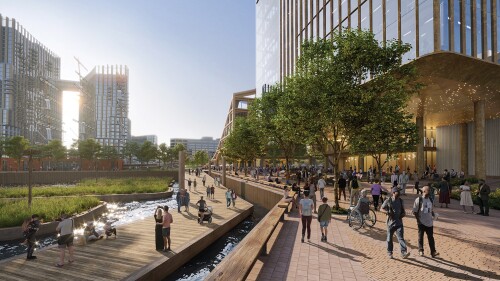A diverse panel of property industry experts pushed back on a recent New York Timesarticle asking, “Why Can’t We Get Cities Right?” during a lively 2017 ULI Fall Meeting session.
“It strikes me, given the situation in the country, [that] city leadership has never been more important,” said Stephanie Meeks, president and chief executive of the National Trust for Historic Preservation.
The panel offered different takes on the myriad issues confronting cities around the United States, from the advent of autonomous vehicles to the value of saving green buildings.
“What has gone wrong is disintegration, the silo-ization of many sectors,” said Jonathan F.P. Rose, president of Jonathan Rose Companies. “Housing has been disconnected from transportation and jobs. What is going right is that this is being reversed.”
In many cities, preserving and restoring old buildings is a key driver in helping create economic resilience and social cohesion, Meeks argued.
“Historic preservation and the role of old buildings are gaining real currency,” she said.
During the Fall Meeting, the National Trust for Historic Preservation and ULI released a new report, Untapped Potential: Strategies for Revitalization and Reuse, focused on strategies to promote building reuse and “unlock the hidden potential of older buildings in American cities.” The result of a five-year study with industry leaders in Baltimore, Chicago, Detroit, Los Angeles, and Philadelphia, the study presents eight strategies to promote reuse. The list includes the increased use of technology tools to identify opportunities, updated zoning codes, increased incentives, and the adoption of adaptive use ordinances.
“The greenest building is the building already built,” Meeks said during the panel discussion.
Autonomous cars were another hot topic of discussion, led by Robin Chase, cofounder of Zipcar and the 2017 recipient of the ULI J.C. Nichols Prize for Visionaries in Urban Development. Driverless vehicles won’t solve problems unless they fit into a new system of shared rides and zero-emission vehicles, she emphasized.
“The way they [autonomous vehicles] could break our system is all reliant on things broken now that we refuse to fix,” Chase said. The reliance on single-occupancy cars, as well as polluting vehicles, “are problems that exist today, and we need to fix them today.”
As part of her recent work, Chase helped develop ten principles of shared mobility, one of which is “build buildings and transportation together,” she said.
For panelist James Murley, chief resilience officer for Miami–Dade County, the issues of resilience are at the forefront, after a summer with two hurricanes. Part of the post–hurricane event is an education process to help people realize that the issues are ongoing, even when there are no hurricanes on the horizon.
“Sea-level rise is not an event, it’s an amplifier to all these events,” Murley said. Miami is going to see flooding from high tides due to sea-level rising long before the next storm, he said. “You have to get in and make the distinction and the events become part of that education,” he said.
Miami is taking several steps to protect the city, including expanding the mangroves to protect the shoreline, Murley said.
Rose pointed to several signs that cities are increasingly finding new ways to create better cities. That includes more “co-optition,” a concept that involves the ideas of cities both cooperating and competing to improve their systems and results, he said.
Several initiatives can help affect income inequality and social cohesion, Rose said. “Beneficial social outcomes actually occur across all forms of housing,” including true community development by private developers.
In the private sector, affordable housing cannot be built without subsidies or some form of incentive, simply due to the economics, he said. But communities could allow accessory dwellings—granny flats—to expand the supply of housing “with little visual impact and without subsidies,” he said.
But the “mismatch between incomes and housing and housing costs” is a structural issue that all cities are confronting, Rose said. “We are at one of the inflection points now.”




